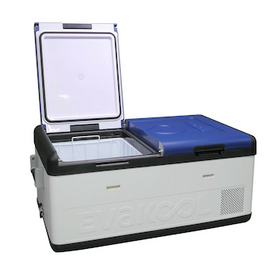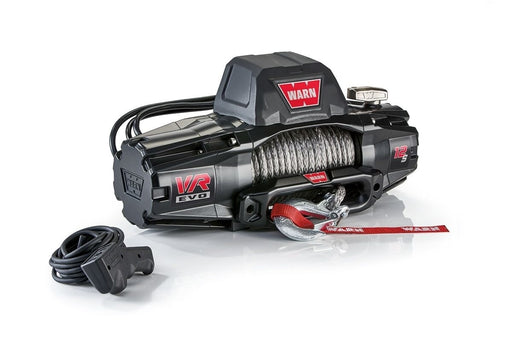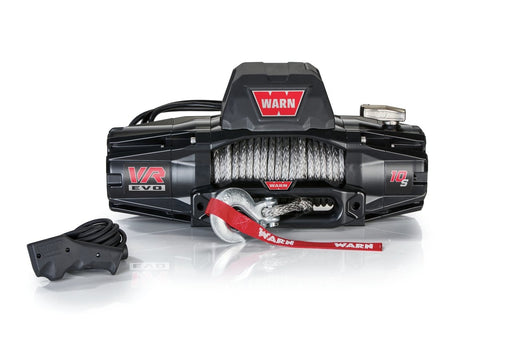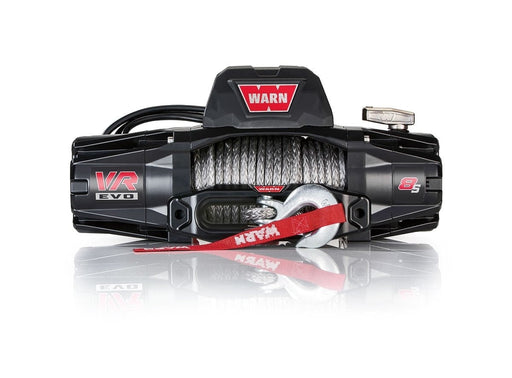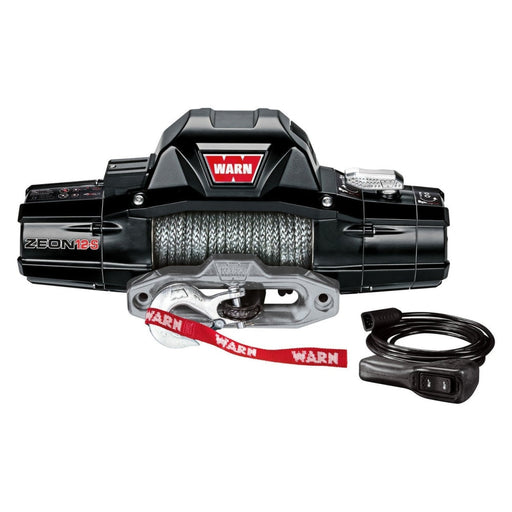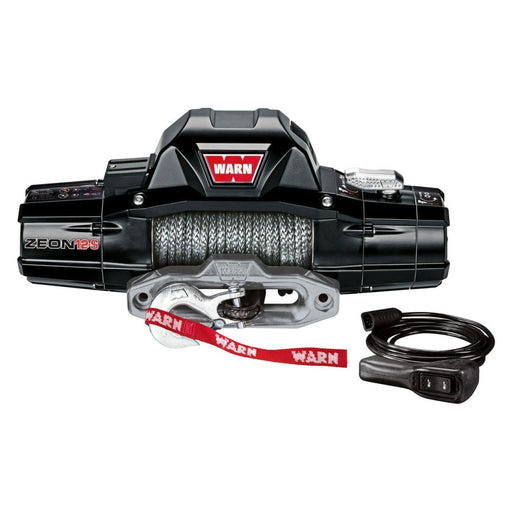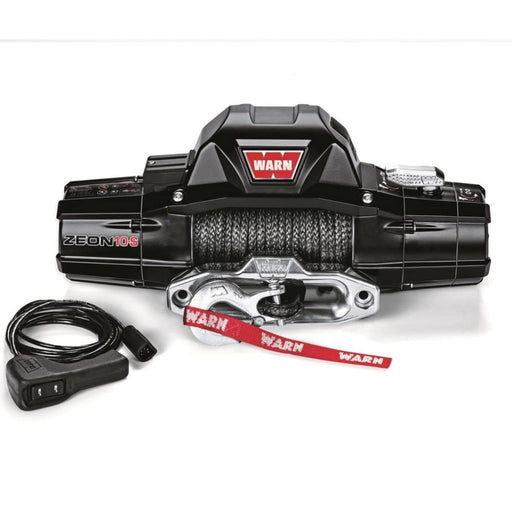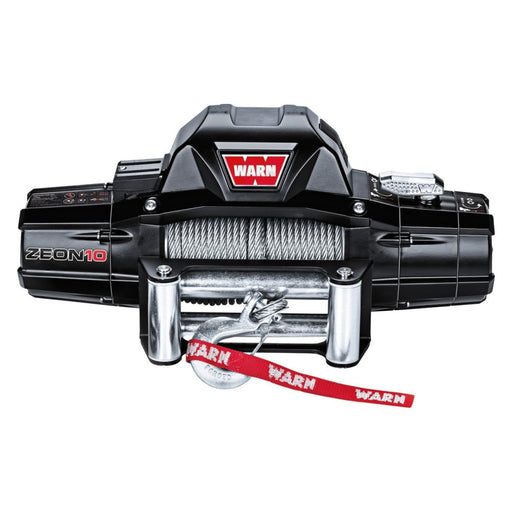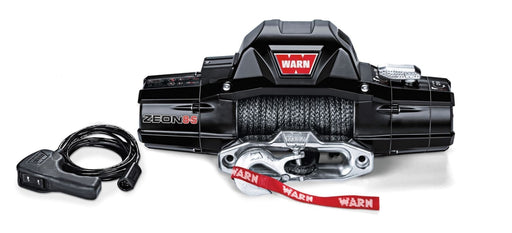Comparing the Warn VR Evo vs the Warn Zeon 4x4 Winches
Wondering which Warn Winch is Right for You? We do a Deep Dive Comparison of the
VR Evo 10-S vs the Zeon 10-S.

Warn is to winches what Apple is to computers. Everybody’s heard of them, most people want one, but not everybody is sure they actually need one, or for that matter - can afford one.
Warn Industries has been in the off-road recovery game for over 75 years, and is highly regarded as one of the leading winch manufacturers in the world. They’ve earned a reputation for producing reliable and high-performance winching solutions, from the small little ATV winches, right up to the big hydraulic models. This reputation really comes from the 4WD community where their winches have proven themselves over the years. While they’re a premium brand at a premium price, the old adage you get what you pay for certainly rings true with Warn.
TABLE OF CONTENTS
- Making the Right Choice
- A Little About the Zeon Series
- A Little About the VR Evo Series
- No-Line Load Speed
- No-Load Current Draw
- Salt Sprary Durability Coating
- Coating UV Stability
- Winch Rope - Standard or Spydura
- IP Ratings
- Wireless Control Integration
- Thru-Drum Rope Anchor
- Winch Drum
- Gear Train
- Control Contactors
- Winch Braking Systems
- Control Box Covers
- Winch Dimensions and Weight
- Conclusion
Making the Right Winch Choice
It’s really important that you select the correct winch for your vehicle. The winch you choose will play a pivotal role in your future vehicle recovery, safety, self-sufficiency, and versatility during your future off-road excursions.
A properly chosen winch not only enables the safe extraction of your vehicle from whatever challenging terrain you find yourself in, but it also promotes self-reliance, making you less reliant on external help. Furthermore, a decent winch should withstand the harsh off-road environment you’ll no doubt encounter, and its versatility extends to aiding others in your group.
Ultimately, choosing the right winch will give you peace of mind, bolster your confidence and allow your future exploration of challenging off-road destinations less intimidating.
This article focuses on two of Warn’s most popular models, the Zeon and the VR Evo. If you’d like to do a more general deep dive into choosing the right winch for your vehicle, make sure you read our Choosing the Best Winch article here.
Today we’re going to break down the differences between two of Warn’s flagship 4x4 Winches. The Warn Zeon and the Warn VR Evo. Each model comes in different line-pull capacity sizes, starting at 8,000lb, through to the 12,000lb models. To keep it simple, we’re going to compare their 10,000lb models:

They also both available with steel cable instead of synthetic rope, and are available in 24v. Again, for the sake of simplicity we’re going to compare their synthetic rope 12v options which are both more popular.
Worth noting is that Warn have also released the Zeon Platinum Series. This series takes everything the Zeon offers one step further. This comparison is with the Zeon, and not the Platinum series.
A Little About Warn Zeon Series Winches
In late 2012 Warn released its most ambitious and advanced series of winches yet, the Zeon Series. The Zeon models stand out from other WARN winches thanks to their unique construction, an array of features, and versatile configurations. These models are available with line pull capacities ranging from 8,000 to 12,000 pounds, offering choices between synthetic rope ("S" models) or steel cable, as well as corded or wireless remote controls, enabling you to tailor your selection to precisely meet your specific requirements.

In late 2012 Warn released it’s most ambitious and advanced series of winches yet, the Zeon Series. The Zeon models stand out from other WARN winches thanks to their unique construction, an array of features, and versatile configurations. These models are available with line pull capacities ranging from 8,000 to 12,000 pounds, offering choices between synthetic rope ("S" models) or steel cable, as well as corded or wireless remote controls, enabling you to tailor your selection to precisely meet your specific requirements.
The Zeon series is also designed and assembled in the United States. While some parts may be sourced externally, the overall winch is heavily machined in the US and built to a higher specification. This of course contributes to the higher price point verse other non-US based winch brands.
A Little About Warn VR EVO Series Winches
The VR Evo series from Warn is actually their third generation of VR winches. Warn winches are traditionally, and proudly, made in the United States. They are after all a very American brand (just watch any of their videos). However the VR series is their one collection of models that are manufactured in China. This was in an attempt for Warn to stay competitive in an ever growing and competitive market.

Now just because they’re made in China doesn’t automatically mean they’re not as good quality. Warn are very quick to point out that their VR line is designed in the US and manufactured to their standards in China. While it’s a popular notion to assume anything made in China will be subpar, there are plenty of brands that prove otherwise. It’s possible to control and dictate the production standards of your manufacturing from outside of China and produce a high-quality item. Apple is a good example of this.
Breaking Down the Zeon vs VR Evo Differences
No-Load Line Speed
The "No-Load Line Speed" in a 4x4 recovery winch refers to the speed at which your winch's cable or rope is pulled in when there is no load or tension on it. In other words, it measures how fast the winch can reel in the cable when there is no resistance or weight being pulled.
A winches no-load line speed is an important factor to consider when choosing a 4x4 recovery winch because it provides an indication of how quickly you can retract the cable when you're not actively pulling or recovering a vehicle. A higher no-load line speed can be an advantage in situations where you need to quickly rewind the cable after a recovery operation or when spooling the rope back onto the winch drum.
With that said, it's important to note that while a high no-load line speed is helpful in some scenarios, the winch's overall performance under load (i.e. when actively recovering a vehicle) is also crucial. A balance between line speed and pulling power is essential to ensure you’re able to effectively (and safely) recover your or another vehicle that gets stuck.
The Zeon has a 18% faster No-Load Line Speed than the VR Evo, which is significant. Details in the table below:
No-Load Line Speed
| Warn VR EVO 10-S Winch | Warn ZEON 10-S Winch |
|---|---|
| 8.5 m/min | 10.1 m/min |
No-Load Current Draw
The term no-load current draw in a 4x4 winch refers to the amount of electrical current that the winch motor consumes when the winch is operating with no load or resistance on the cable. Essentially it measures how much electrical power the winch motor requires from the battery to turn the drum and spool in the cable when there is no weight or tension being pulled.
Understanding the no-load current draw is important because it provides insights into the power efficiency of the winch. A lower no-load current draw indicates that the winch motor is more energy-efficient when operating without a load. This can be helpful for several reasons:
Battery Life: A winch with lower no-load current draw will drain your vehicle's battery less when you're using the winch without a load, which is particularly important in situations where you’re a thousand miles from anywhere and the last thing you need is a drained or damaged battery.
Reduced Heat: Less current draw under no-load conditions means the winch motor generates less heat, which can extend the motor's lifespan and prevent overheating during prolonged winching operations.
Efficiency: Lower current draw reflects a more efficient motor design, which can be an indicator of the winch's overall quality and performance.
In summary, no-load current draw is a key specification to consider when evaluating the efficiency and performance of a 4x4 recovery winch, as it can impact your vehicle's electrical system, battery life, and the winch's long-term reliability.
The Warn Zeon 10-S draws 7.5% less amps than the VR Evo 10-S. Another significant spec when one considers the importance of battery health, heat and overall efficiency.
Warn VR EVO 10-S vs ZEON 10-S Amp Draw
| Warn VR EVO 10-S Winch | Warn ZEON 10-S Winch |
|---|---|
| 67 amp | 62 amp |
Salt Spray Durability Coating (hr)
Anyone who’s taken their 4x4 onto the beach, or anywhere coastal knows the dangers of salt water on their vehicle. The same goes for a winch. Salt spray durability coating in the context of an electric 4x4 winch refers to the ability of the winch's protective coating to withstand exposure to salt spray or saltwater for a certain number of hours before showing signs of corrosion or deterioration. It is a measure of the winch's resistance to the corrosive effects of salt, which will obviously be most important to those of us who plan to use their winch in coastal environments. It can also be factor in areas where road salt is commonly used to de-ice roads.

This specification indicates how long the winch's coating can endure exposure to a salt spray without exhibiting visible signs of rust, degradation, or damage. A longer duration of salt spray durability (measured in hours) is generally considered a positive feature, as it indicates that the winch is less likely to corrode or suffer from salt-related damage when used in harsh, corrosive environments.
The Warn Zeon has a 1.7 x corrosion resistance rating verse that of the VR Evo.
Warn VR EVO 10-S vs ZEON 10-S Salt Spray Durability (hr)
| Warn VR EVO 10-S Winch | Warn ZEON 10-S Winch |
|---|---|
| 240hrs | 408hrs |
Coating UV Stability (KJ-h)
If you’re considering a Warn winch, then it’s fair to say you take some pride in the visual aesthetic of your vehicle. The "Coating UV Stability (KJ-h)" specification of a 4WD winch relates to the protective coating of the winch, and it’s ability to withstand ultraviolet (UV) radiation exposure over a specified period, measured in kilojoules per hour (KJ-h). This measurement assesses the coating's resistance to the potentially harmful effects of prolonged exposure to the harsh Australian sun.

While this specification may sound like overkill, UV stability should be an important consideration for your 4x4 winch. Depending how you install your winch, and whether it’s exposed to the UV rays or not, can open it up to various issues if it doesn’t have a solid protective UV coating. UV radiation from the sun can cause various issues, including:
Fading: Prolonged UV exposure can lead to the fading of paint or protective coatings, which can affect the winch's appearance.
Deterioration: UV rays can lead to the deterioration of materials, making them brittle or causing surface damage.
Corrosion: In some cases, UV exposure can contribute to the breakdown of coatings, leaving the underlying metal vulnerable to corrosion.
This specification is particularly relevant for us off-road enthusiasts who use our winches in outdoor settings where prolonged exposure to the blistering Aussie sun is common. A winch with good UV stability will have a longer-lasting and more reliable protective coating, ensuring that it remains functional and visually appealing even after extended periods of outdoor use.
The Warn Zeon has a 1.6 x UV resistance rating verse that of the VR Evo.
Warn VR EVO 10-S vs ZEON 10-S Coating UV Stability (KJ-h)
| Warn VR EVO 10-S Winch | Warn ZEON 10-S Winch |
|---|---|
| 400KJ-h | 800KJ-h |
Synthetic Winch Rope - Standard Synthetic Winch Rope vs Spydura Winch Rope
Warn is one of the few winch brands that have their own patented winch rope. Warn acquired Spydura in 2010, and the Spydura name is now used for Warn's synthetic winch ropes on a number of their high-end models.

Warn Spydura winch ropes are made from a unique ultra high molecular weight polyethylene material that is stronger and lighter than traditional steel winch ropes. Spydura ropes are also more resistant to abrasion and UV damage.
To be fair we’ve never had any issues with Warn’s standard synthetic rope, nor have we had problems with their Spydura branded rope, which they claim is superior and 20% stronger than their standard rope. Aside from strength, the Spydura does have a few features that set it apart from the standard rope. The winch line features a red heat-resistant Nomex® sleeve, which protects the first layer of rope from the drum temperature and is also a visual end-of-line warning, a ballistic nylon sliding sleeve and a gusseted thimble. The sleeve has a loose fit so it can easily be positioned along the rope to protect it from rough surfaces and sharp corners.
The VR EVO 10-S includes their standard synthetic rope, while the ZEON 10-S includes their Spydura rope. Both ropes come in 9.5mm width. The VR Evo includes a shorter length at 27.4m in length, while the Zeon includes 30.4m of rope.
Winch Rope included with Warn VR EVO 10-S vs ZEON 10-S
| Warn VR EVO 10-S Winch | Warn ZEON 10-S Winch |
|---|---|
| 9.5mm x 27.4m of Standard Synthetic Winch Rope | 9.5mm x 30.4m of Spydura Synthetic Winch Rope |
IP68 Waterproof Rating
A winch by its very nature is bound to find itself in either very dusty environments, very wet environments or a muddy combination of the two. And this is where a high IP rating comes into play. An IP68 rating in a 4x4 winch refers to the Ingress Protection (IP) rating assigned to the winch, specifically indicating its resistance to dust and water. The "IP" code is followed by two numbers, and in this case, "IP68" breaks down as follows:
The "6" indicates the level of protection against solid particles, particularly dust and debris. A rating of "6" signifies that the winch is dust-tight, meaning it's effectively sealed against the entry of dust and other solid contaminants.
The "8" indicates the level of protection against liquids, especially water. A rating of "8" indicates that the winch is designed to be waterproof and can be submerged in water to a specific depth without allowing water to get inside.

The importance of an IP68 rating in a electric 4WD winch lies in the following aspects:
Durability: As mentioned earlier, off-road recovery winches are often used in harsh, outdoor environments where they are exposed to plenty of dust, dirt, mud, and water. An IP68-rated winch is highly durable and can withstand these elements without compromising its performance.
Reliability: The IP68 rating is a sign that the winch's internal components are well-protected from dust and moisture, reducing the risk of damage or malfunction. This will then enhance the winch's long-term reliability and functionality.
Safety: For both the winch and the operator, having an IP68-rated winch means you can confidently use it in wet and muddy conditions without worrying about water damage or electrical issues.
Versatility: It goes without saying that an IP68-rated winch can be considered versatile and can be used in a wide range of environmental conditions, including river crossings and other scenarios where water exposure is likely.
Extended Lifespan: The protection offered by the IP68 rating contributes to the extended lifespan of the winch, reducing the need for frequent maintenance and replacement.
Both the VR Evo and Zeon series are fully IP68 rated, with one small caveat. *Warn state that the Zeon is IP68 rated and can be operated while submerged, while the VR Evo should not be operated while submerged.
In summary, an IP68 rating in a 4x4 recovery winch should provide peace of mind for you, knowing that your winch is well-protected against dust and water, which will ultimately contribute to its longevity and performance.
Warn VR EVO 10-S vs ZEON 10-S IP Rating
| Warn VR EVO 10-S Winch | Warn ZEON 10-S Winch |
|---|---|
| Yes | Yes* |
Wireless Control Integration
Wireless remote control is a great feature, and one that has become common place with leading winch manufactures. If the winch doesn’t come with a wireless remote, then it’s usually an accessory that’s available. Wireless control in a 4x4 winch provides several practical advantages and enhances the overall usability and safety of using a winch in your recovery.
Without overstating the obvious, having wireless control of your winch allows you to stand at a safe distance from the winch while operating it, reducing the risk of injury in case of cable snapback, vehicle movement, or other winching-related hazards.
It also eliminates the need for manual tethered controls, making the winching process more convenient and user-friendly. It allows you to control your winch from a location that offers a better view of the situation.
Wireless remotes can be operated from various positions around the vehicle, making it easier to guide the winching process and maintain visibility.
And don’t forget the obvious - vehicle clutter. Without the need for physical control cables, there is less clutter around the winch and your rig. It also reduces the likelihood of cables getting tangled or damaged during use.
In emergency situations, wireless control can be more convenient and quicker to use, allowing for faster response times when it's essential to act swiftly.
Wireless winch control also allows you to multi-task. It allows you more flexibility to multitask and coordinate the recovery without being tethered to a control cable.
Wireless controls work well in a variety of weather conditions, and many are designed to be water-resistant or waterproof, making them suitable for use in wet or muddy off-road environments.
In summary, wireless control in a 4x4 winch enhances safety, convenience, and precision during recovery operations. It provides you with the flexibility to manage the winching process from a safe and strategic location, improving overall efficiency and minimising risks associated with a vehicle recovery.
The Warn VR Evo Winch series include wireless control built in. While many other models require two separate remotes, Warn provide a single 2-in-1 remote that can be both plugged into a cable or it can be unplugged and run wirelessly. Best of both! How good is that?

The Warn ZEON Series comes with a wired controller only, but does provide the option of adding wireless via an optional wireless accessory kit.
Warn VR EVO 10-S vs ZEON 10-S Wireless Integration
| Warn VR EVO 10-S Winch | Warn ZEON 10-S Winch |
|---|---|
| Yes | Optional |
Warn's Thru-Drum Winch Rope Anchor
A "thru-drum rope anchor" refers to a specific design feature related to how the winch drum is constructed to secure the winch rope. This design, patented by Warn, allows the winch drum to anchor the rope securely as it passes through the drum, providing better rope management, stability, and control during winching operations.

Warn Zeon drum with 'Thru-Drum Rope Anchor'.
Here's how the Thru-drum rope anchor works and why it's important:
Secure Rope Anchoring. A thru-drum rope anchor typically includes a slot or anchor point on the drum's surface that securely holds the winch rope in place as it wraps around the drum. This prevents the rope from slipping or becoming dislodged during operation. In the case of the Warn Zeon winch, this is a channel that runs through the drum. The winch rope is threaded through the channel in the drum and is held in place by a steel anchor.
Most winch brands use a much more simple means of attaching the rope to the drum. The more common method of securing the rope to the winch drum is by attaching the end of the rope to the drum using a small bolt of puck. This is simply a method of holding the rope in place on the drum, but provides little to no strength and means that if the rope gets wound all the way out to the connection point, it can just be ripped away from the drum without much effort. This is obviously far from ideal as it’s a safety risk, and can lead to damage of the rope, and the winch.

Warn VR Evo drum with standard rope bolt connection.
The thru-drum method of anchoring is much stronger and a far more secure means of holding the rope in place. Warn state that the anchoring key alone can hold up to 10,000lb of pull if required. We don’t suggest testing this, but it’s nice to know there’s some strength there if need be.
The VR EVO secures the rope to the drum using a washer and bolt attached to the side wall of the drum. This means you’ll need a minimum of 11 wraps of rope around the drum to avoid the rope slipping and pulling out of the bolt attachment. This isn’t necessary with the Zeon’s thru-drum connection although they still recommend a minimum of 5 wraps to give the rope some extra hold on the drum.
Warn VR EVO 10-S vs ZEON 10-S Thru-Drum Rope Anchor
| Warn VR EVO 10-S Winch | Warn ZEON 10-S Winch |
|---|---|
| No | Yes |
Winch Drum
The Warn VR EVO 10-S Winch drum has a diameter of 6.6cm and made from welded steel. The Zeon is a larger 8cm drum diameter, made from an aluminium zinc alloy. The winch drum on the Zeon has the benefits of reducing wear on the rope, and allowing better heat dissipation.
Warn VR EVO 10-S vs ZEON 10-S Winch Drum
| Warn VR EVO 10-S Winch | Warn ZEON 10-S Winch |
|---|---|
| 6.6cm Welded Steel Drum | 8cm Aluminium Zinc Allow Drum |
Gear Train
The Zeon has a much stronger gear train compared to that of the VR Evo. The patented motor design in the Zeon also runs much cooler than the VR Evo. This means the Zeon is able to achieve a higher duty cycle and in turn gives it a longer life in extreme conditions.
The two winches also have slightly different gear ratios. The Zeon has a gear ratio of 216:1 while the VR Evo has a gear ratio of 218:1. This means the Zeon will be slightly faster than the VR Evo.
Warn VR EVO 10-S vs ZEON 10-S Gear Train
| Warn VR EVO 10-S Winch | Warn ZEON 10-S Winch |
|---|---|
| 218:1 | 216:1 | Stronger gear train with higher duty cycle |
Control Contactors
The VR EVO winch utilise electrical cables to connect the control box to the winch whereas the Zeon uses industrial based bus bars to transfer power. This setup is much more efficient in power transfer.

By removing the cables from the equation means less chance of a cable being pulled or getting damaged accidentally, plus it looks a whole lot cleaner.
Warn VR EVO 10-S vs ZEON 10-S Control Contactors
| Warn VR EVO 10-S Winch | Warn ZEON 10-S Winch |
|---|---|
| Electrical Cables | Industrial Bus Bars |
Winch Braking System
The importance of the brake system in your winch cannot be overstated. The brake will play a pivotal role in your recovery and needs to be able to withstand a huge amount of pressure. Winching you vehicle up a hill will likely require a fair amount of stop start operation, and it’s during these pauses that the brake needs to hold your vehicle in place.
The Zeon and the VR Evo use two different brake systems. The Zeon uses a Cone style brake, and the VR Evo uses the spring style brake.
In a spring style brake system, a spring is used to exert pressure on the drum to keep it from turning. The spring pushes against a brake band or a set of brake pads when the winch is not actively powering the rope in or out.
In a cone style brake, a conical brake assembly is used. When the winch motor is not actively pulling the rope, the conical brake applies pressure to the winch drum.
The cone style brake is considered the better of the two. They’re known for their reliability and ability to provide consistent and precise control over the winch drum.
Warn VR EVO 10-S vs ZEON 10-S Braking System
| Warn VR EVO 10-S Winch | Warn ZEON 10-S Winch |
|---|---|
| Spring Style | Cone Style |
Control Box Cover
A small but notable difference between the Zeon and VR Evo winches is their control box covers. The Zeon series comes with a metal-armoured control box cover, while the VR Evo comes with a plastic control box cover. Now considering the brain of your winch lives in the control box, it’s important that it’s protected. Even more so if your winch will be mounted on the outside of your bull bar (as seen in various Jeep setups). As it’s more exposed to the elements, the chances of it coming into contact with something in the environment is high and so having a re-inforced housing can’t hurt.
Warn VR EVO 10-S vs ZEON 10-S Braking System
| Warn VR EVO 10-S Winch | Warn ZEON 10-S Winch |
|---|---|
| Plastic | Metal |
Physical Size
The physical size difference between the two winches is quite substantial. The VR Evo comes in a more compact form, which is ideal if you don’t have a lot of space available in your bar. While the Zeon comes in a larger form factor and weight.
Warn VR EVO 10-S vs ZEON 10-S Dimensions and Weight (mm/kg)
| Warn VR EVO 10-S Winch | Warn ZEON 10-S Winch |
|---|---|
| 534 L x 160.5 D x 256mm H Weight: 25.1kg | 615.9 L x 181.6 D x 267.1mm H Weight: 37kg |
Conclusion
So out of the two models, the Warn Zeon 10-S and the Warn VR Evo 10-S, which winch is right for you?
Based on the above there’s a lot to consider but we really believe it boils down to two main factors. Budget and requirements.
If you’re looking for a price competitive winch primarily for personal use now and then, from one of the leading winch brands in the world, the VR Evo will do the job and do it well.
On the other hand, if you’ve got the budget and would prefer something more robust, heavy duty, and is up there with the creme of the crop, the Zeon would be the way to go.
We hope this has been a helpful resource in your journey to finding the perfect winch for your vehicle. As always, if you need a little more guidance or have questions feel free to reach out. We’d be happy to help.

